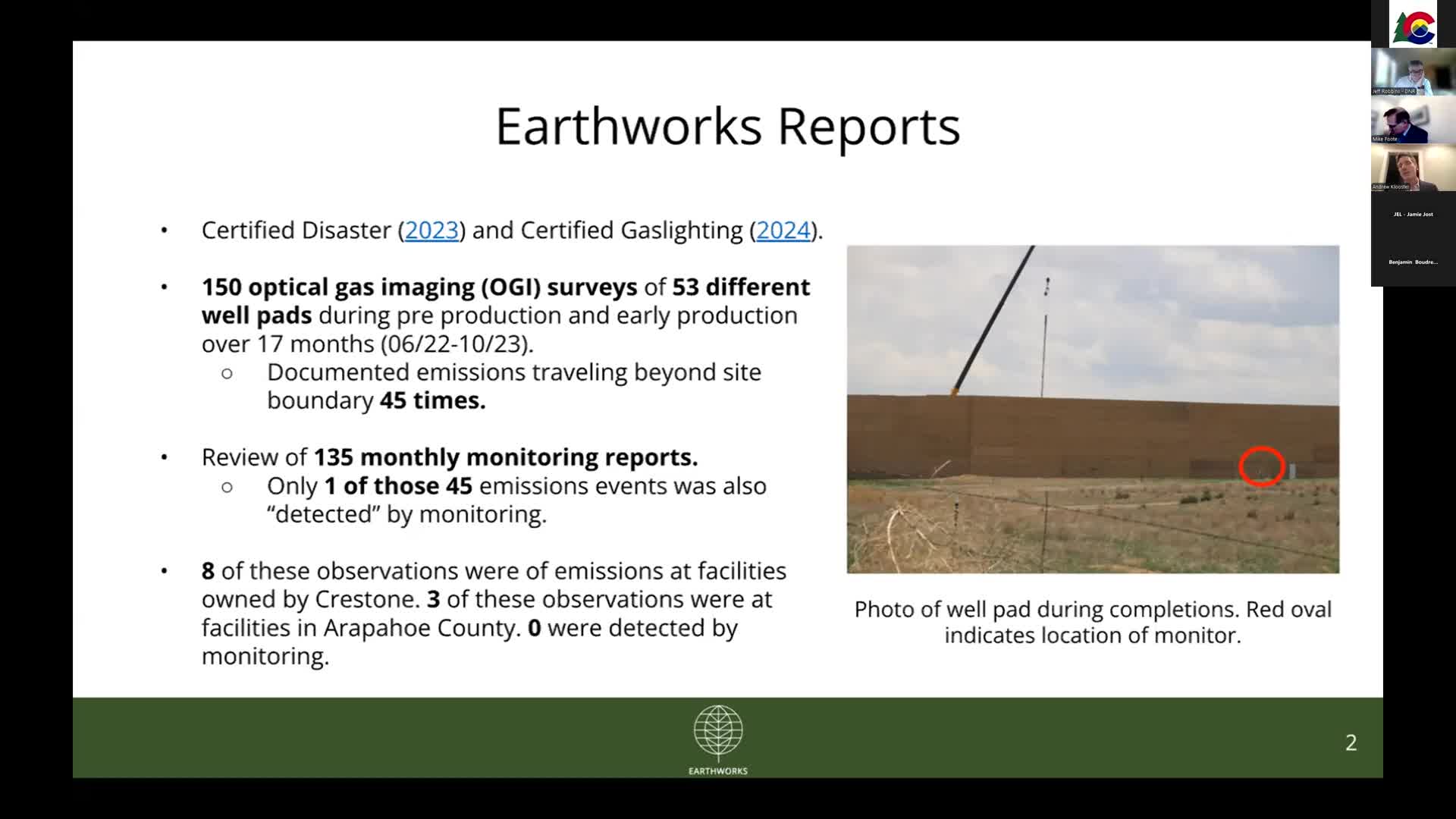Experts show optical‑gas imaging plumes missed by continuous monitors and say moving Sunlight Long pad would cut perceived noise
November 24, 2025 | Energy and Mineral Impact Assistance State Advisory Committee, Governor's Boards and Commissions, Organizations, Executive, Colorado
This article was created by AI summarizing key points discussed. AI makes mistakes, so for full details and context, please refer to the video of the full meeting. Please report any errors so we can fix them. Report an error »

DENVER — During testimony on Nov. 21, independent witnesses flagged possible gaps in the preproduction monitoring and community‑noise analysis proposed for the Sunlight Long site.
Andrew Kloster of Earthworks summarized OGI fieldwork covering roughly 150 field surveys of pads across Colorado and described 45 observed off‑pad hydrocarbon emission events that, in the organization’s conservative cross‑check, did not show up in operators’ monthly continuous‑monitor reporting. “Only one of those 45 instances where we observed hydrocarbon emissions traveling beyond pad boundaries was potentially picked up by a monitor,” Kloster said. He explained that photoionization‑detector style monitors used around pad perimeters typically require direct plume contact to register events, a limitation that can leave short‑duration or directionally transported plumes undetected.
Separately, acoustician William Thornton presented a longer‑term ambient noise study commissioned by STAR and criticized the opacity of Crestone’s noise‑model inputs. Thornton reiterated the basic acoustic physics used in regulatory practice: doubling the distance between noise source and receiver typically reduces the measured level by about 6 decibels. He calculated that siting the pad at the alternate site Civitas identified would reduce community sound levels by roughly 7–8 dB and could largely offset the modeled noise increase attributed to operations.
Both experts told commissioners that while recent rule revisions for Reg 7 improve monitoring reporting and standardize data, technical and deployment limitations remain: monitors can miss emissions and short‑term plume events; they typically do not quantify speciated concentrations; and enforcement options for temporary preproduction sources are limited. Kloster urged the commission to consider community exposure consequences when approving development near populated areas; Thornton said moving the pad is a practical mitigation that would materially lower noise impacts.
Andrew Kloster of Earthworks summarized OGI fieldwork covering roughly 150 field surveys of pads across Colorado and described 45 observed off‑pad hydrocarbon emission events that, in the organization’s conservative cross‑check, did not show up in operators’ monthly continuous‑monitor reporting. “Only one of those 45 instances where we observed hydrocarbon emissions traveling beyond pad boundaries was potentially picked up by a monitor,” Kloster said. He explained that photoionization‑detector style monitors used around pad perimeters typically require direct plume contact to register events, a limitation that can leave short‑duration or directionally transported plumes undetected.
Separately, acoustician William Thornton presented a longer‑term ambient noise study commissioned by STAR and criticized the opacity of Crestone’s noise‑model inputs. Thornton reiterated the basic acoustic physics used in regulatory practice: doubling the distance between noise source and receiver typically reduces the measured level by about 6 decibels. He calculated that siting the pad at the alternate site Civitas identified would reduce community sound levels by roughly 7–8 dB and could largely offset the modeled noise increase attributed to operations.
Both experts told commissioners that while recent rule revisions for Reg 7 improve monitoring reporting and standardize data, technical and deployment limitations remain: monitors can miss emissions and short‑term plume events; they typically do not quantify speciated concentrations; and enforcement options for temporary preproduction sources are limited. Kloster urged the commission to consider community exposure consequences when approving development near populated areas; Thornton said moving the pad is a practical mitigation that would materially lower noise impacts.
View the Full Meeting & All Its Details
This article offers just a summary. Unlock complete video, transcripts, and insights as a Founder Member.
✓
Watch full, unedited meeting videos
✓
Search every word spoken in unlimited transcripts
✓
AI summaries & real-time alerts (all government levels)
✓
Permanent access to expanding government content
30-day money-back guarantee

